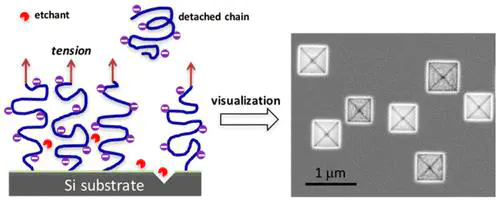Visualization of Mechanochemically-Assisted Degrafting of Surface-Tethered Poly(Acrylic Acid) Brushes

Abstract
We report visualization of mechanochemically assisted degrafting of surface-tethered poly(acrylic acid) (PAA) brushes in a basic aqueous buffer at nanometer to micrometer length scale by monitoring changes in local etching of silicon substrates. PAA brushes were prepared by surface-initiated atom transfer radical polymerization and incubated in 0.1 M ethanolamine buffer (pH 9.0) with 0.5 M NaCl. Morphological changes of the underlying substrates were monitored by scanning electron microscopy and atomic force microscopy. The appearance of regular-shaped pits indicated etching of the substrate, and both their number and size grew with increasing incubation time. We compared the etching behaviors for PAA, poly(methyl methacrylate) (PMMA), and poly(poly(ethylene glycol) methacrylate) (PPEGMA) brushes grafted on silicon substrates. After incubation for 7 days, the substrate of PMMA brush remained intact. In PAA brush systems, we detected the formation of a few large pits whose size grew in time. Many pits showed up on the substrate of PPEGMA brush but with substantially smaller size compared to PAA. Our findings suggest that hydrophobicity and stability of the grafted polymers play an important role in the morphological changes of the underlying silicon substrates under given incubation conditions.